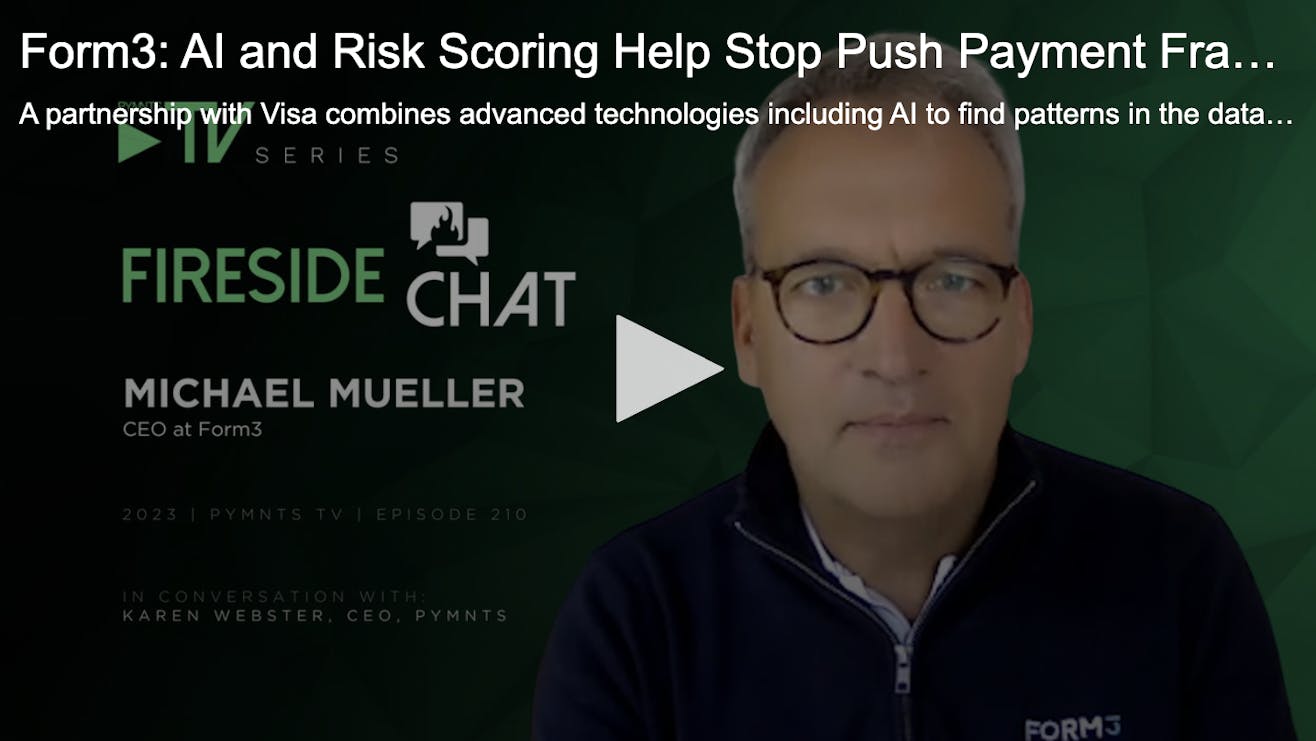Form3: AI and Risk Scoring Help Stop Push Payment Fraud ‘in Its Tracks’
Thought Leadership· 3min October 4, 2023
With the Sibos 2023 financial services conference in the rearview mirror, central bank digital currencies (CBDCs) and blockchain in active discussion, and the FedNow® Service in the news, Form3 CEO Michael Mueller observed to Karen Webster:
“Payments are still an exciting growth business, despite the fact that they’ve been around for so long.”
Topping the list, he said, has been the move to faster payments in the United States, where the transfer of funds in real time represents a seismic shift in money movement that brings with it a knotty problem of faster fraud.
As Mueller noted, with Form3’s own experience through the years enabling more than 10% of the faster payments volume in the United Kingdom, there are some lessons already learned, harbingers for what’s to come stateside.

What’s on the Horizon
“I’m 100% convinced that we’ll see more fraud in those markets,” he said.
The attack vectors and points of vulnerability don’t lie within banks’ infrastructure or the payments ecosystem. They’re round in on platforms in the real world, where unwitting account holders are tricked into making payments they hadn’t intended to make — or they’re sent to fraudulent accounts through push payment fraud and misdirected payments.
The rise of faster fraud, said Mueller, has put pressure on the financial institutions (FIs), and specifically on their know your customer (KYC) processes and account opening checks. The issue is underscored by PYMNTS Intelligence, which showed the cost of fraud has been on the rise for nearly half of FIs as measured against last year. Misuse of account information is tied to more than a third of fraudulent transactions as bad actors impersonate banking officials, the IRS or take on other authoritative personas via social engineering. The fraudsters are using advanced technologies, too, to try and make off with ill-gotten gains.
“It’s a bit of an arms race,” said Mueller, as banks do battle with criminals in a high-stakes, high-tech duel.
No Magic Bullet
There’s no single solution that represents the proverbial silver bullet or magic wand. But banks, according to Mueller, have several weapons at hand to combat fraud, chiefly through the data they have, and smart analytics that can make use of that data while the payments are still flowing. There are already some advances seen in the U.K. that have been somewhat useful in battling fraud, as confirmation of payee helps ensure that account numbers and names match the intended recipient.
“Every one of these initiatives and tools will chip away at and reduce push payments fraud and make it harder for the fraudsters to get a hold of your money,” said Mueller.
Building robust lines of defense is imperative for FIs, said Mueller, as regulations and mandates dictate that banks implement fraud protection technology. In the U.K. for yet another example, new liability rules that will go into effect in 2024 have moved tech investments to high-priority status. And banks, he added, “have a moral obligation to do everything they can do to keep their customers safe.”
Mueller’s conversation with Webster came days after Form3 announced that Visa invested in Form3’s account-to-account platform model. With access to the platform, Visa’s clients can modernize their payments infrastructure and beef up their own fraud-fighting capabilities. The collaboration leverages Visa’s artificial intelligence (AI) and real-time risk scoring to help identify patterns and card-based transactions that, according to Mueller, “reveal the likelihood of a fraudulent payment.”
“For the first time, we’re able to use card-based fraud prevention technology in the real-time payments world,” Mueller said.
The card-based schemes have had best practices in place when it comes to real-time fraud prevention because they have the on-the-ground insight into eCommerce and point-of-sale activity, he said.
There’s an extra buffer of security — in proof of concept with several banks — said Mueller, who added that the risk scoring happens in near real time (in the space of milliseconds) when the payment has yet to be sent to the central infrastructure or to clearing and settlement.
“This means that we can stop payment fraud in its tracks before it actually happens because we can make sure the money never leaves the customer’s account,” he said.
As he noted to Webster, “the rails that we have for the banks — and the scores that we can generate ourselves with the data sets we have and the AI that we use … this will provide the highest level of protection in real-time payments.”
Originally published on PYMNTS.com









 Back to News
Back to News